Actinides and the $r$-process

LA-UR-19-30941
Matthew Mumpower
Workshop on nuclear physics for astrophysical phenomena
Wednesday Oct. 23$^{rd}$ 2019

Center
for Theoretical
ASTROPHYSICS
To understand the formation of the elements
Requires deep knowledge of a range of fields, including:
The theoretical modeling of astrophysical environments
Multi-messenger observations (gravitational waves, EM waves, etc.)
Nuclear theory predictions for exotic nuclei
Precision experiments to constrain nuclear theory
Data and observations are limited
We must be clever when deciphering what is going on with nucleosynthesis...

When we model nucleosynthesis
We want to describe the abundances observed in nature

But there is uncertainty in:
The astrophysical conditions (large variations in current simulations)
The nuclear physics inputs (1000's of unknown species / properties)
Inputs from nuclear physics
1st order: masses, $\beta$-decay rates, reaction rates & branching ratios

What do we know?
The chart of nuclides

What do we know?
All half-lives

What do we know?
Nuclear masses
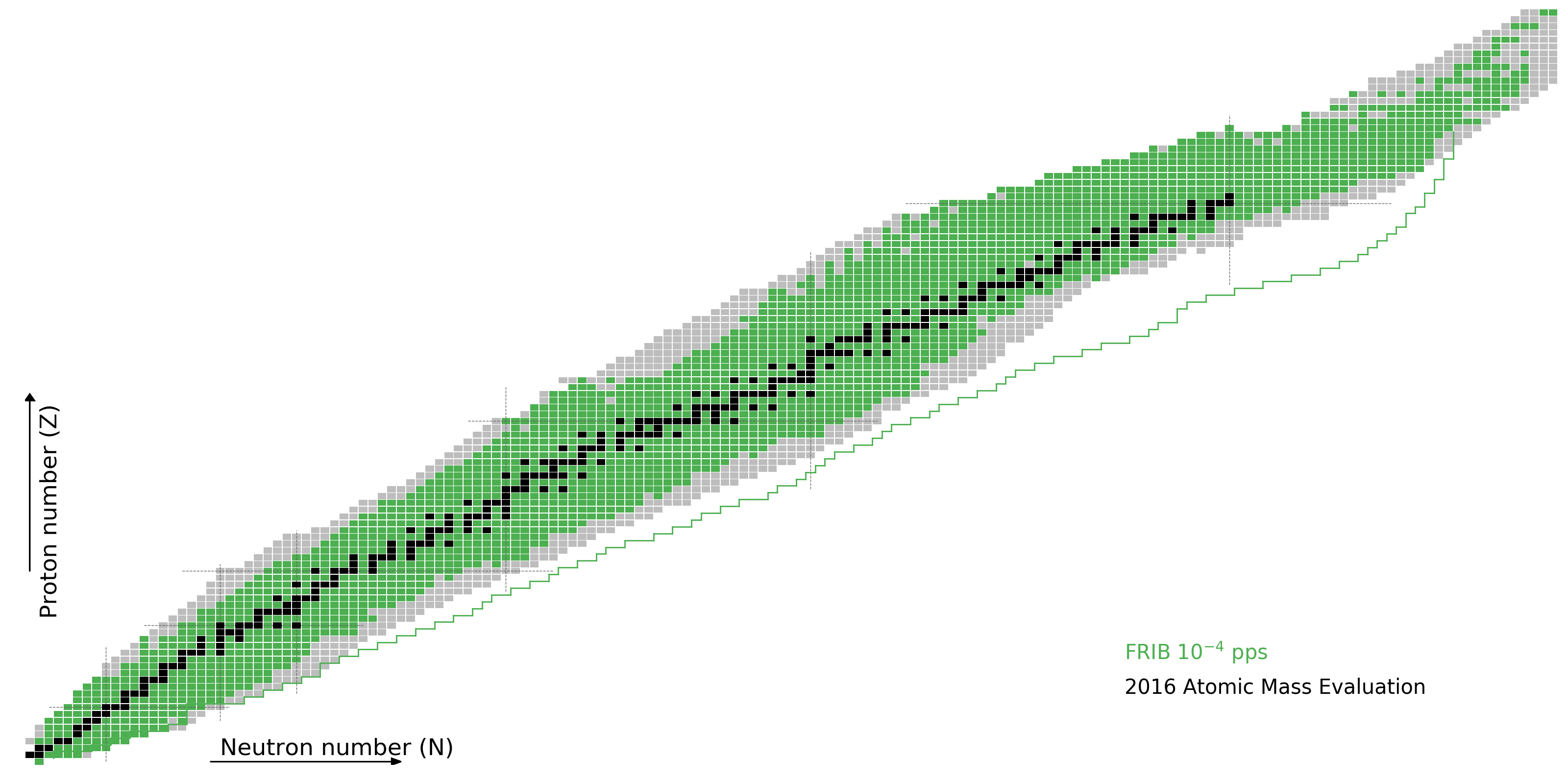
What do we know?
Neutron capture rates
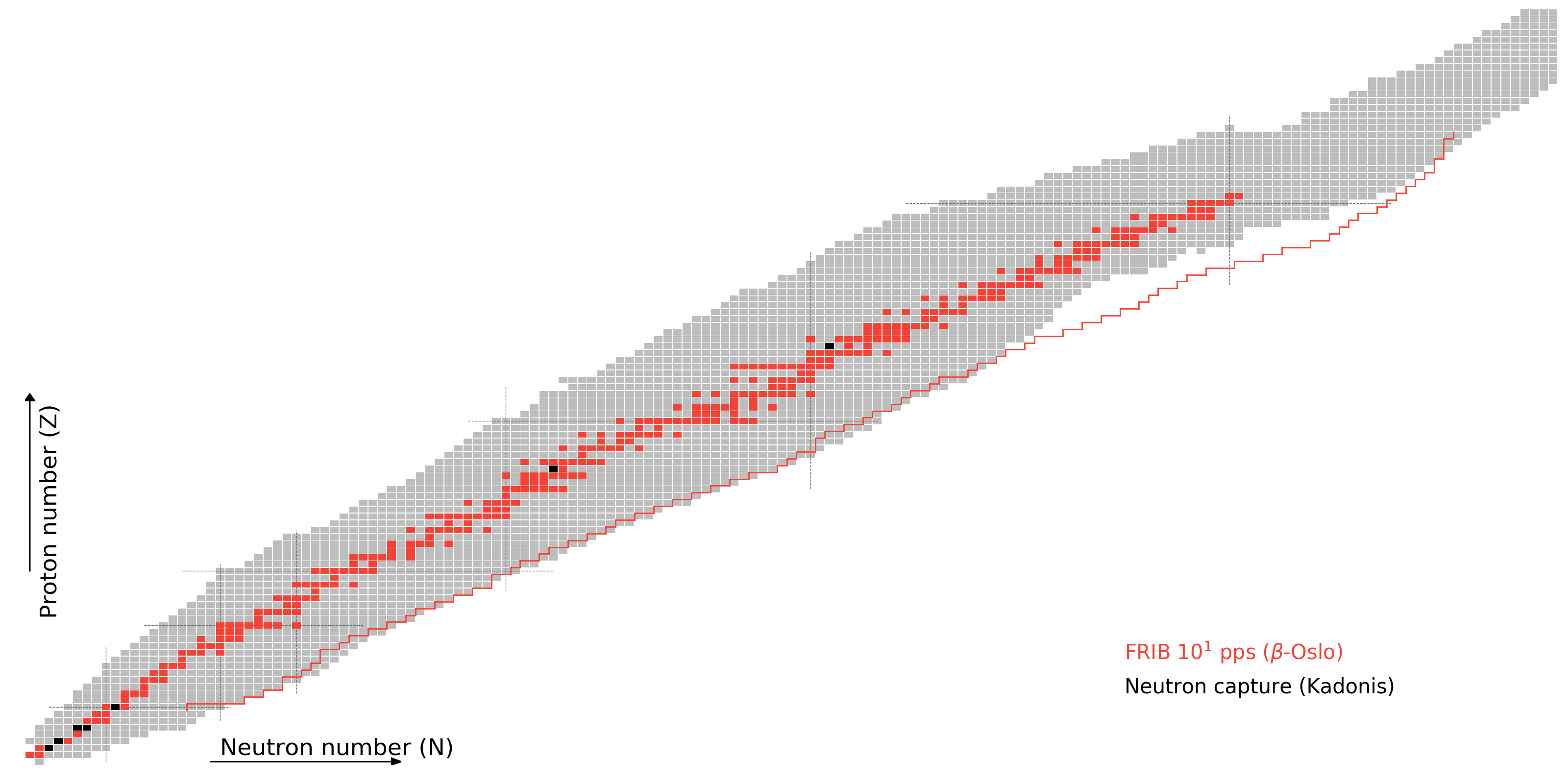
What do we know?
As of today, to varying degrees of accuracy
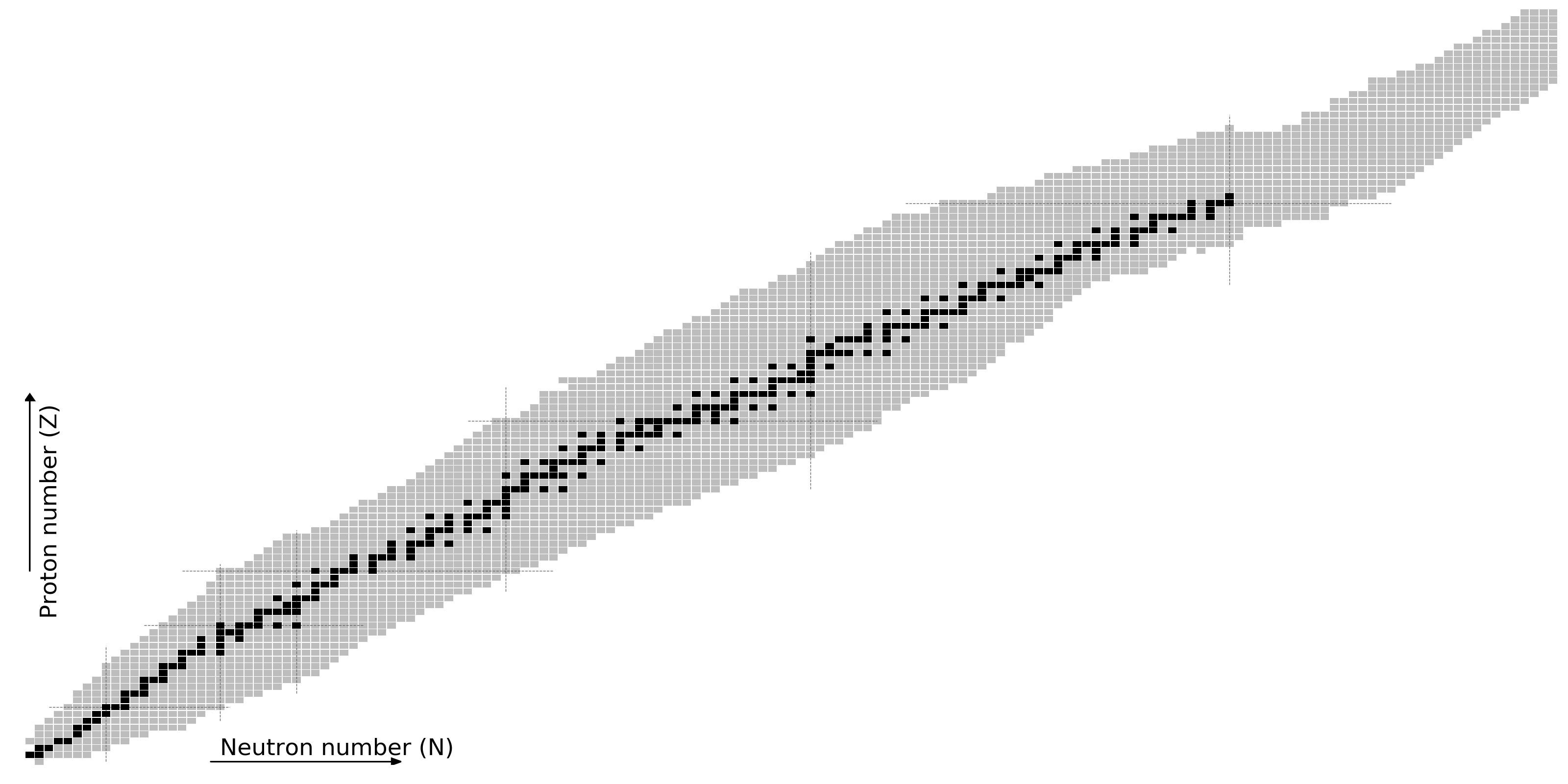
The r-process requires nuclear theory
Even in the era of FRIB
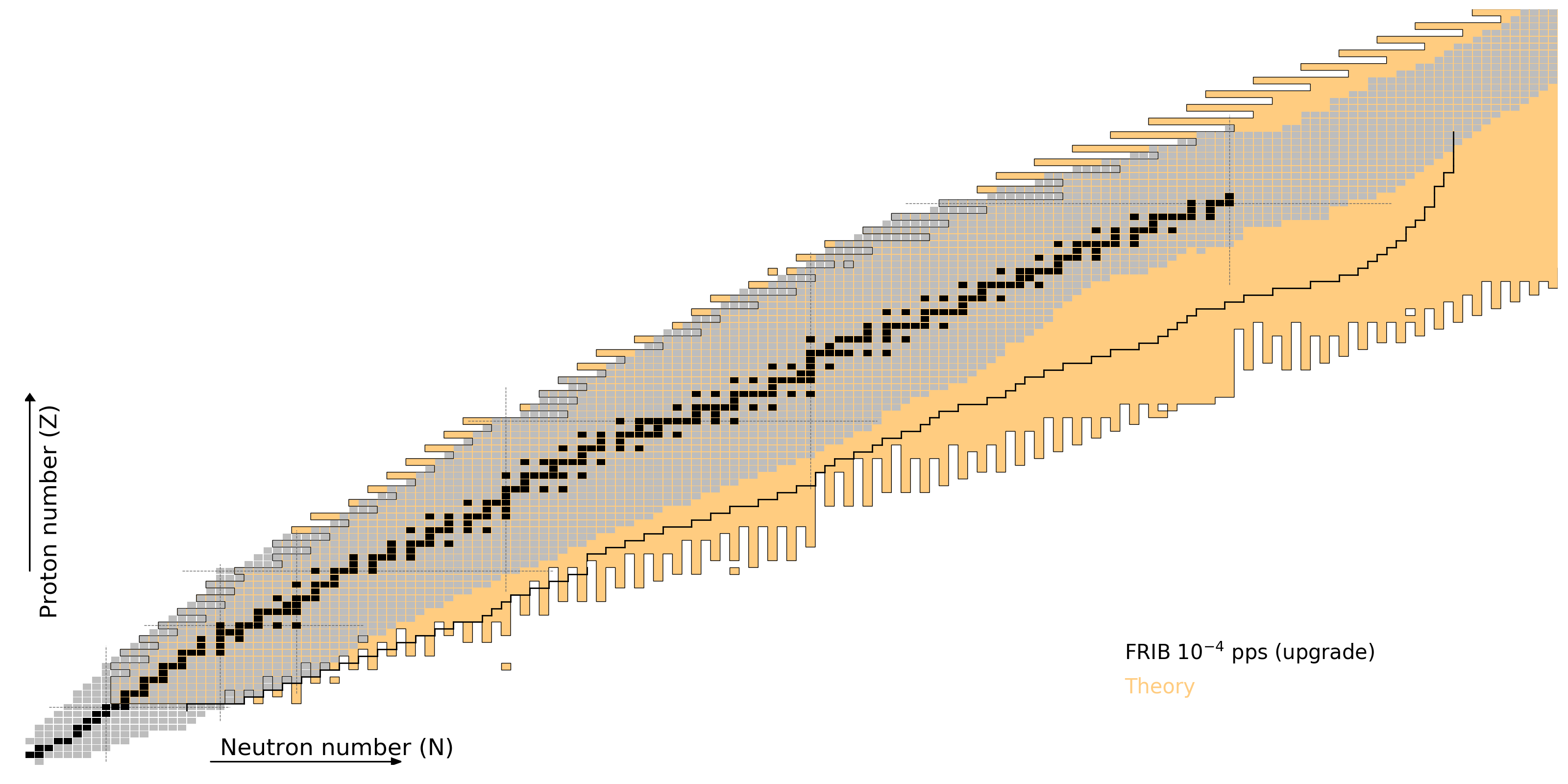
$r$-Process Calculation
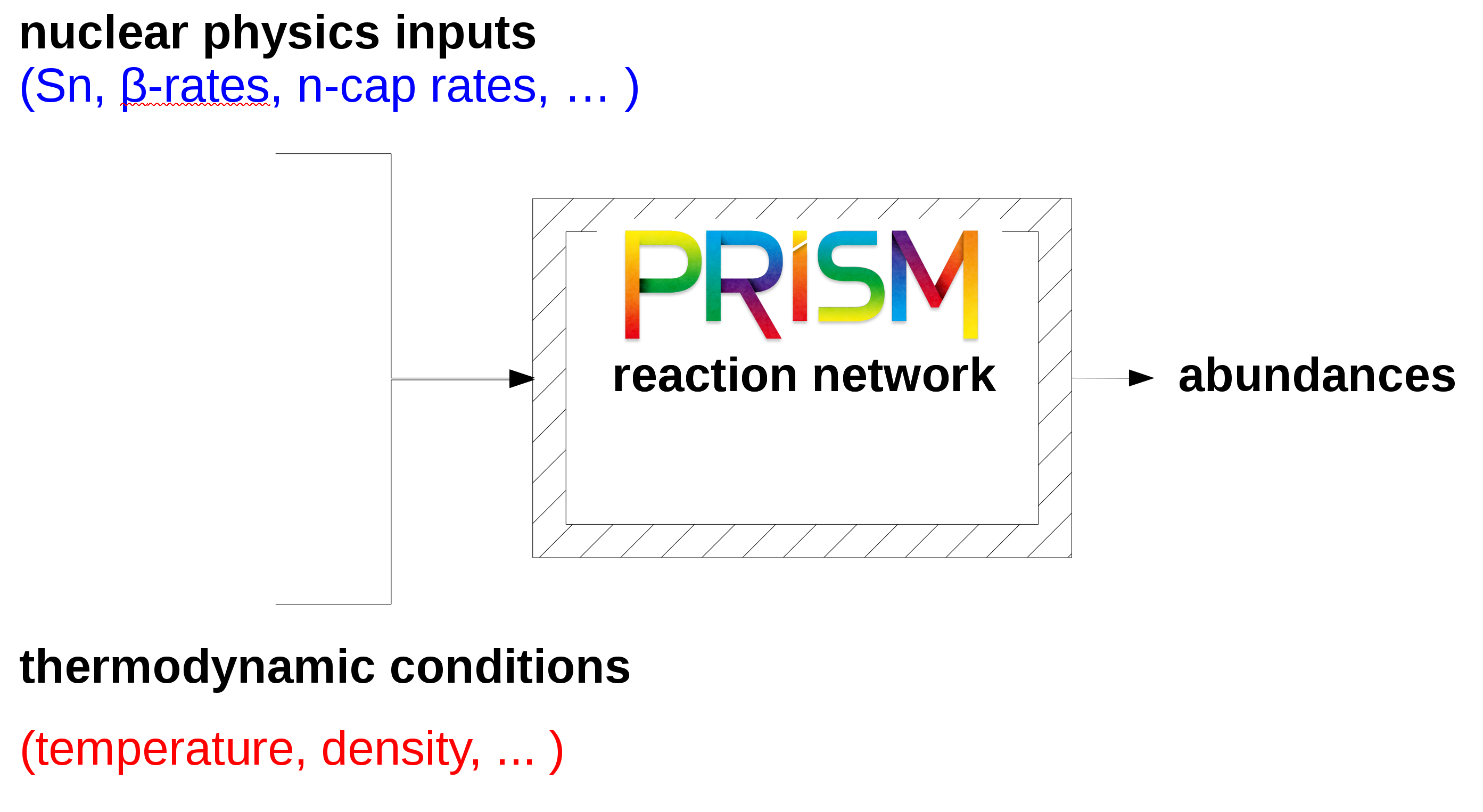
PRISM: Portable Routines for Integrated nucleoSynthesis Modeling
Actinide production
in the $r$-process
Distribution of $Y_e$ for merger disk
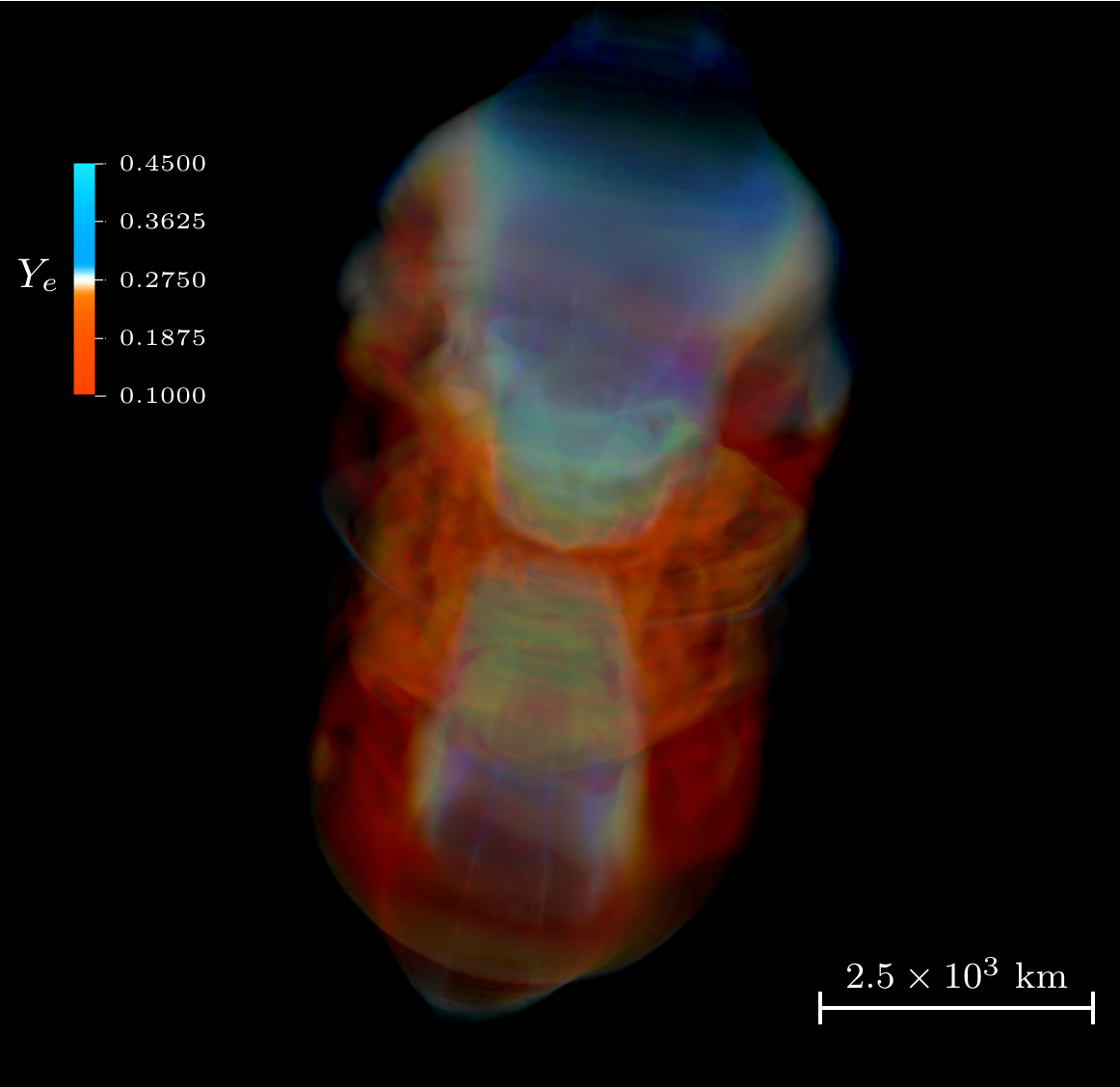
Volume rendering of electron fraction, $Y_e$ for a neutron star merger disk
Jet drives material and voids region near azimuthal axis; high $Y_e$
Morphology of ejecta
Accretion Disk
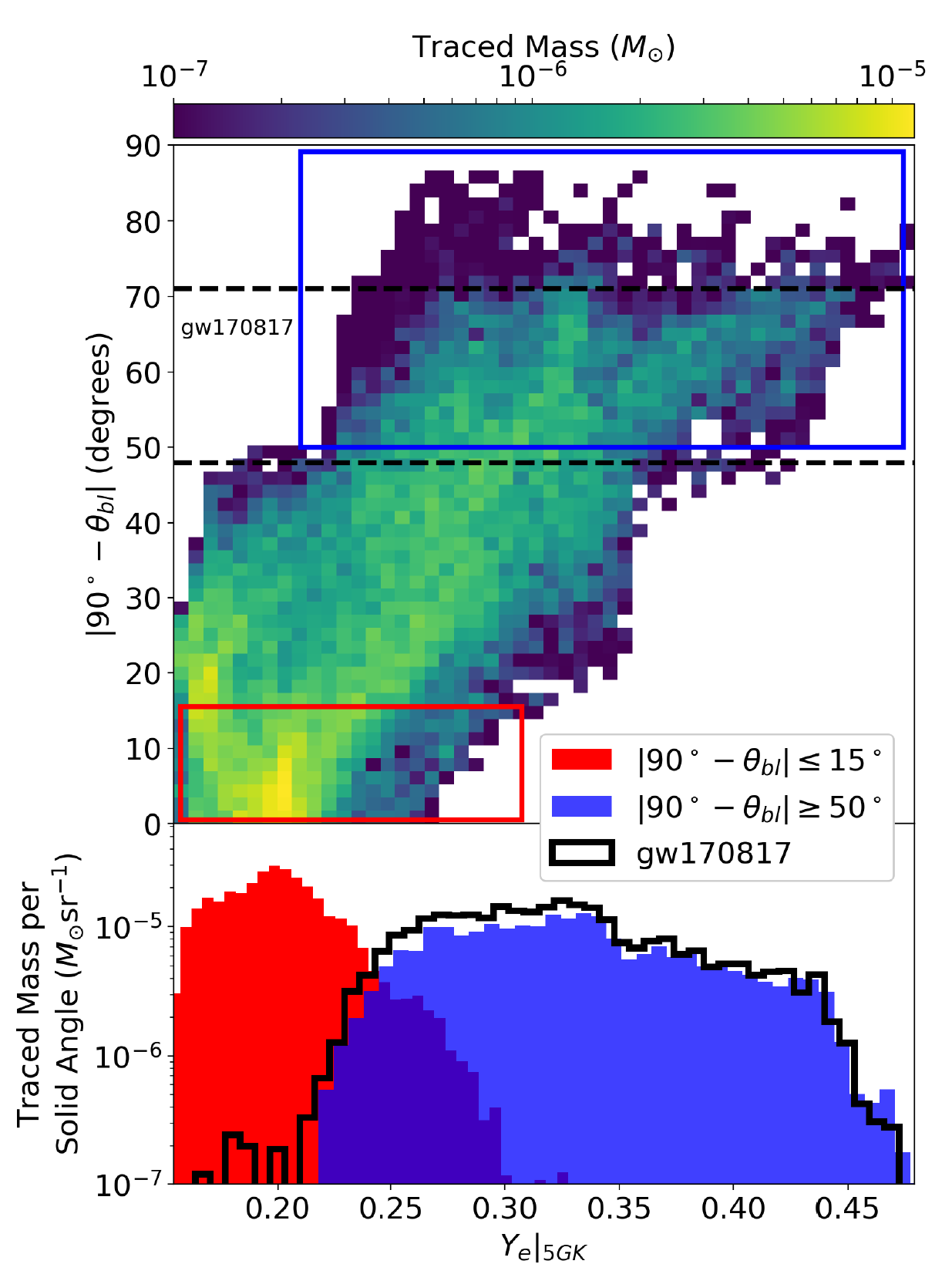 |
Surrounding a black hole Viewing angle critical for what composition you see Measured from the mid-plane of the disk Our model is consistent with observations of a blue kilonova Red, full $r$-process material seen near mid-plane The disk can contain a large amount of material But exactly how much is gravitationally unbound? Further... What is the important role of neutrinos? |
|---|
Neutrinos impact the nucleosynthesis
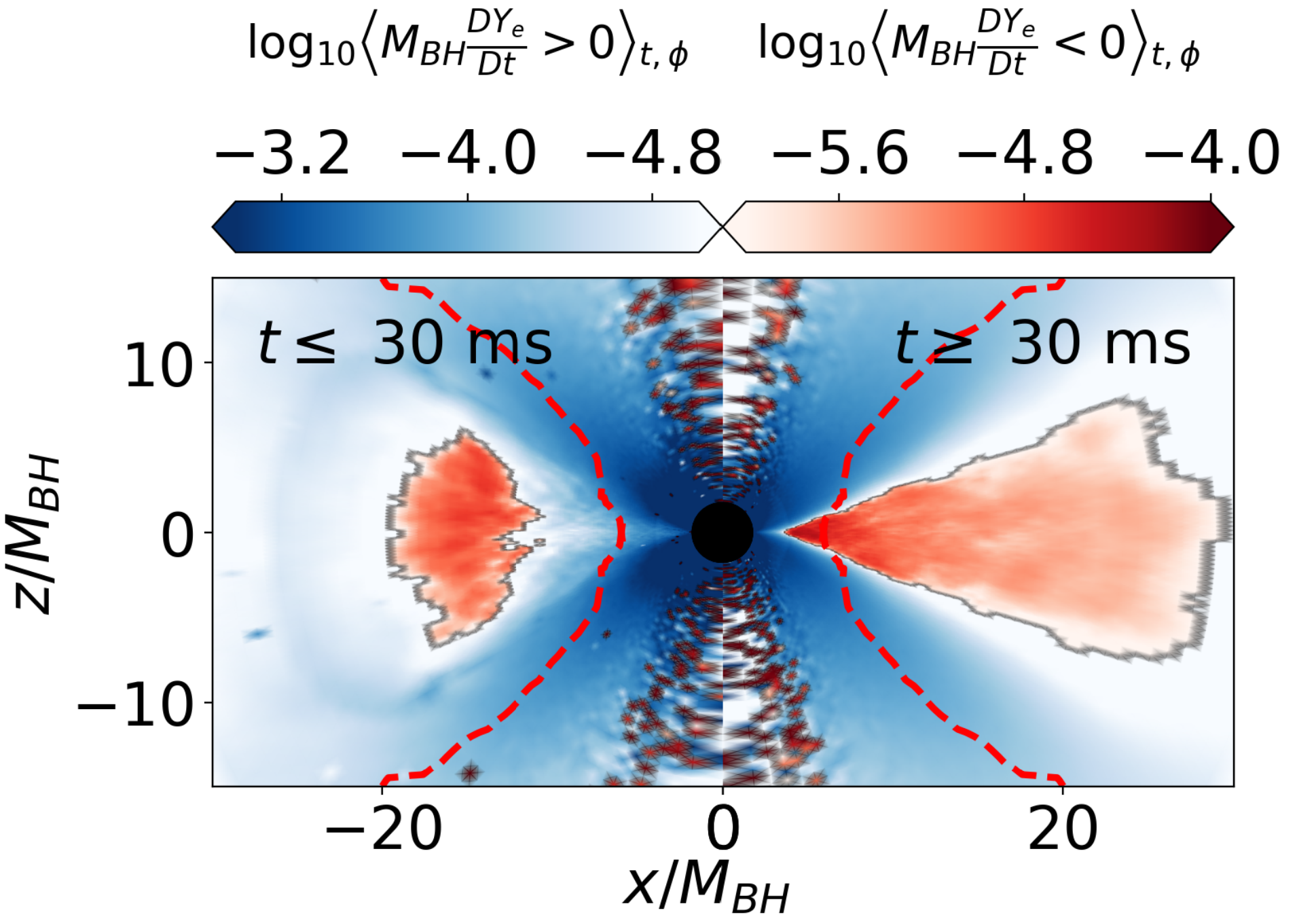
Open question: exactly how is the ejecta processed by neutrinos?
Blue region has high $Y_e$; red lower $Y_e$
The transit time away from the disk is crucial
Resultant nucleosynthesis

Nucleosynthesis simulation with J. Lippuner's SkyNet
Mass weighted trajectories suggest blue kilonova if viewing angle is similar to GW170817
It is critical to get the full morphology and thereby composition correct...
Inferring composition is tricky
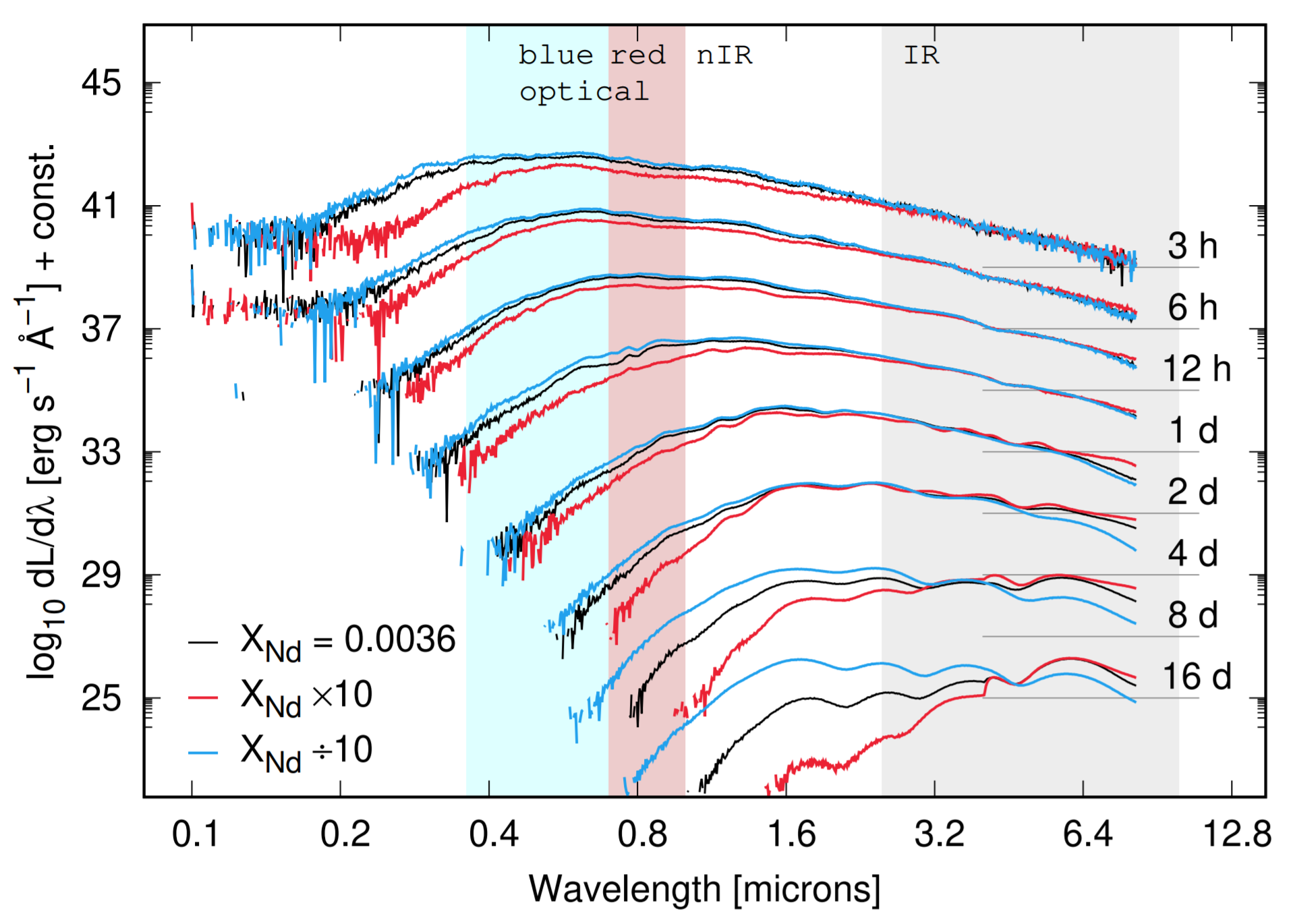
One way is to find a proxy in the observed light curve spectrum
Nd is a good choice because it is a high opacity lanthanide
The amount of Nd is absolutely crucial to the observed light curve
But it is important to remember that there are still many astrophysical model degeneracies as this point...
Especially for solar-like ratios
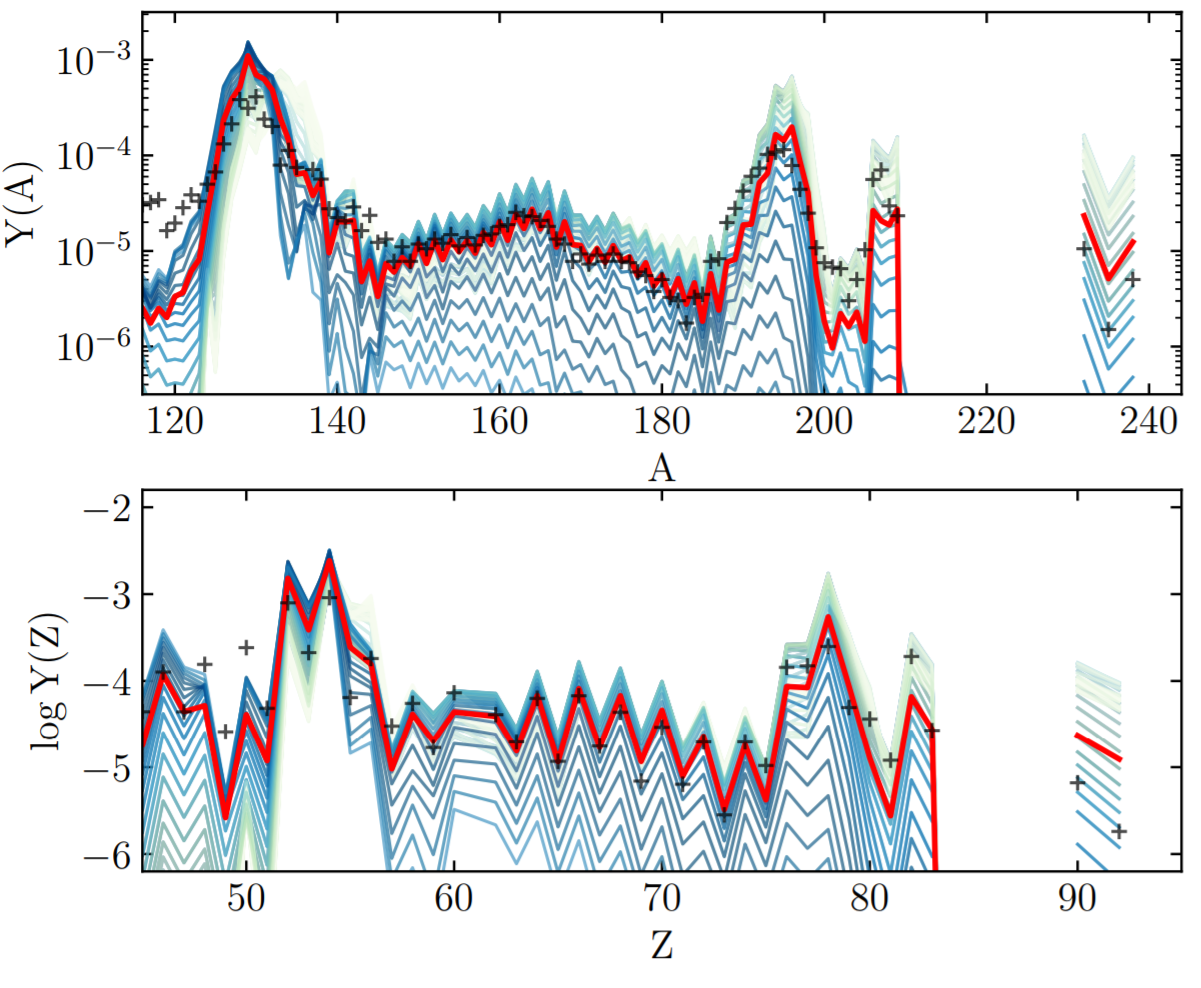
In some simulations actinides seem to be overproduced versus lanthanides
A sufficient amount of dilution with ligher $r$-process material is required to match the solar isotopic residuals
∴ Fission theory has implications far beyond nucleosynthetic outcomes; e.g. for galactic chemical evolution, etc.
Nuclear fission theory
for the production of the heaviest elements
Nuclear fission in a nutshell
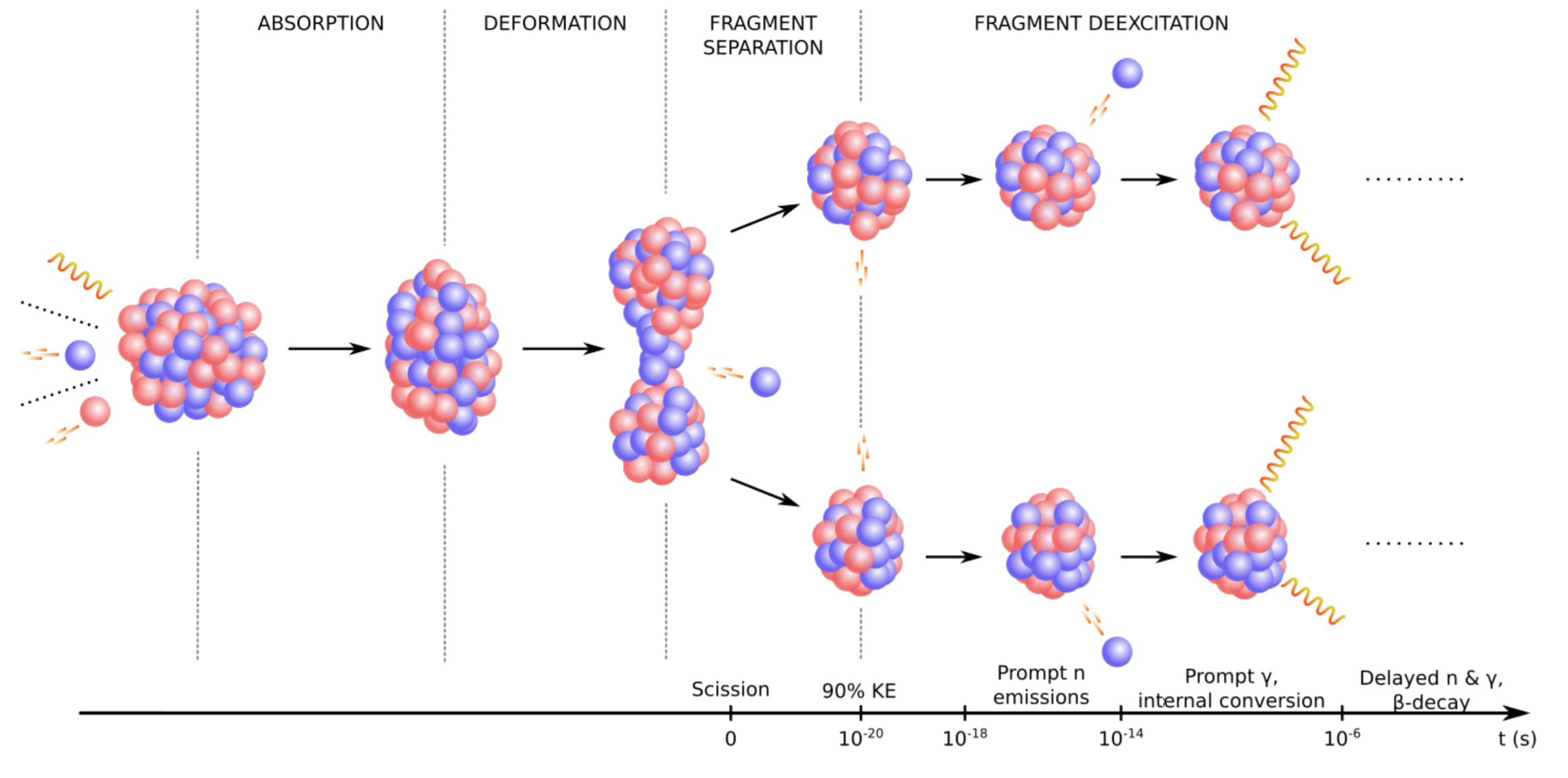
The fission process:
A heavy nucleus splits into two lighter fragments
Subsequent particle emission and decays then occur
Many events gives rise to fission yield
Nuclear fission for the $r$-process

Influence on the $r$-process:
Fission rates and branching determine re-cycling (robustness)
Fragment yields place material at lower mass number; barriers determine hot spots
Large Q-value ⇒ impacts thermalization and therefore possibly observations
Responsible for what is left in the heavy mass region when nucleosynthesis is complete ⇒ "smoking gun"
$\beta$ -delayed fission
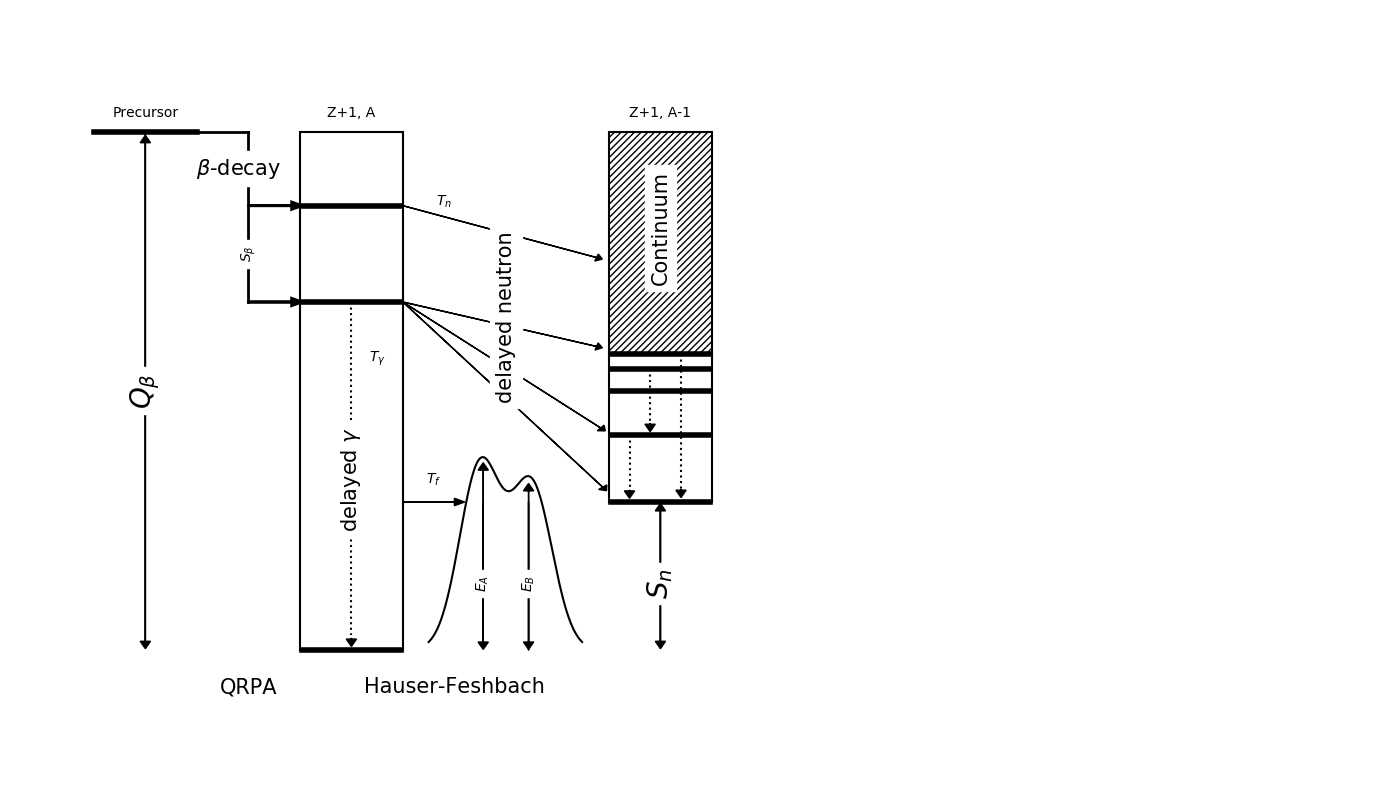
We have recently extended our QRPA+HF model to describe $\beta$-delayed fission ($\beta$df)
Barrier heights from Möller et al. PRC 91 024310 (2015)
Assumes a Hill-Wheeler form for fission transmission
Yokoyama et al. PRC (2019) • Mumpower et al. ApJ (2018)
Multi-chance $\beta$ df
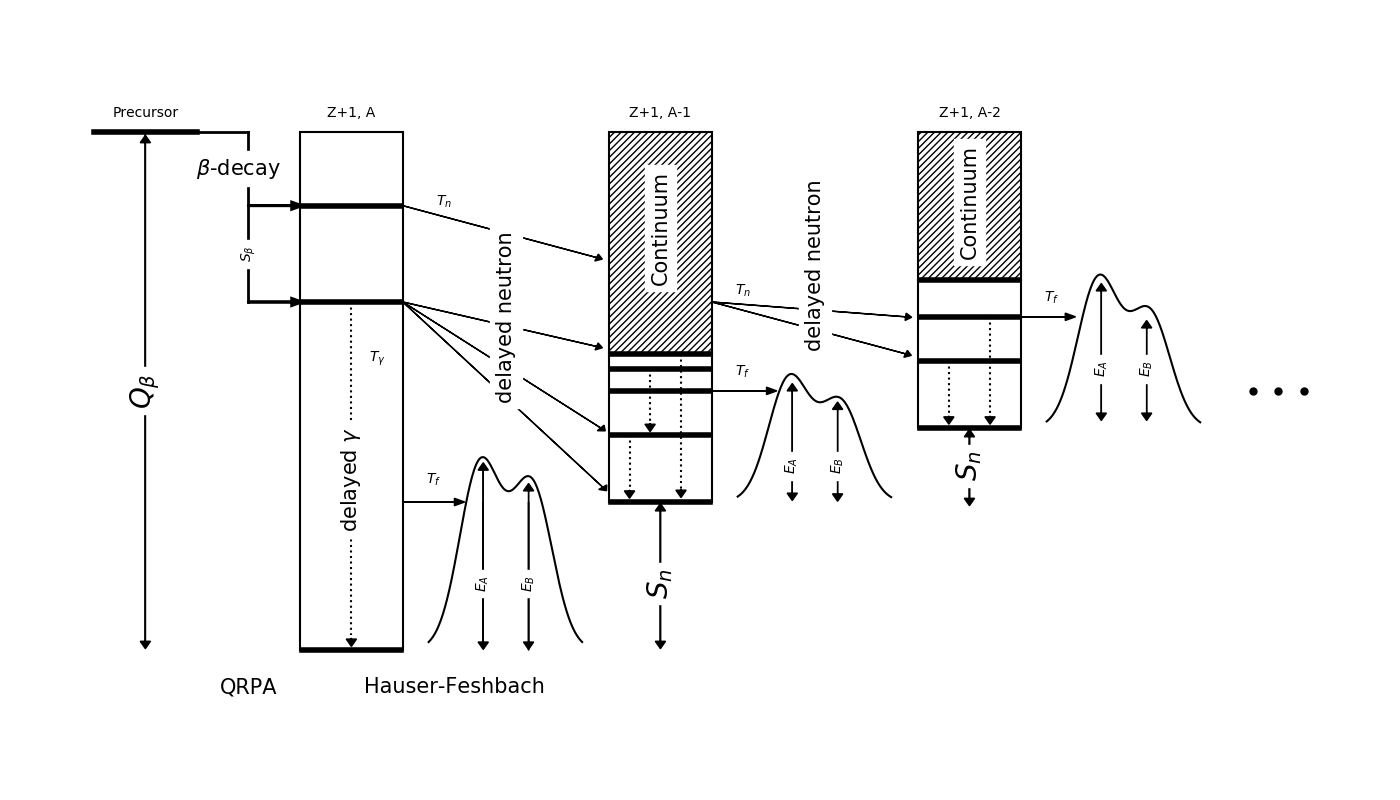
Recall: Near the dripline $Q_{beta}$ ⇡ $S_{n}$ ⇣
Multi-chance $\beta$df: each daughter may fission
The yields in this decay mode are a convolution of many fission yields!
Yokoyama et al. PRC (2019) • Mumpower et al. ApJ (2018)
Cumulative $\beta$ df probability
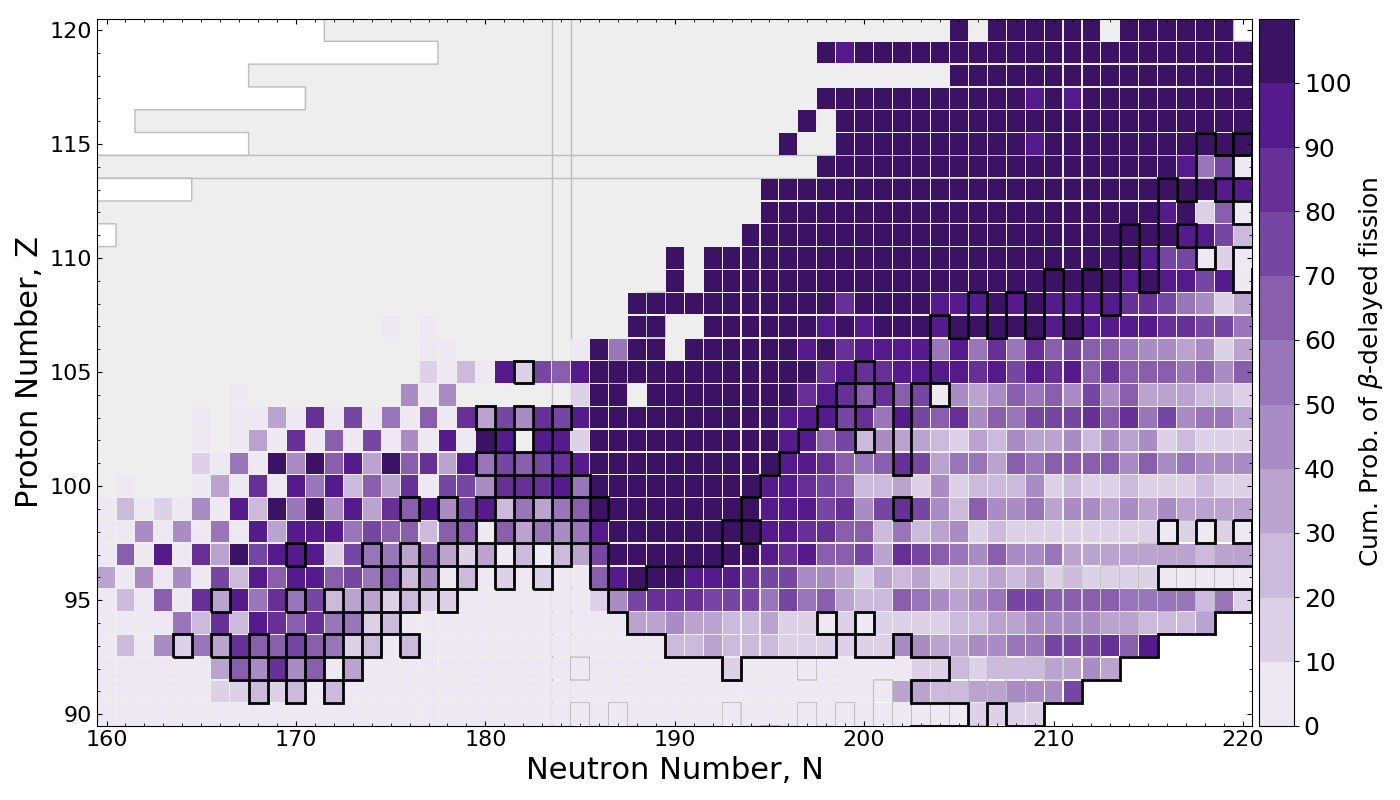
$\beta$df occupies a large amount of real estate in the NZ-plane
Multi-chance $\beta$df outlined in black
Application to the $r$-process
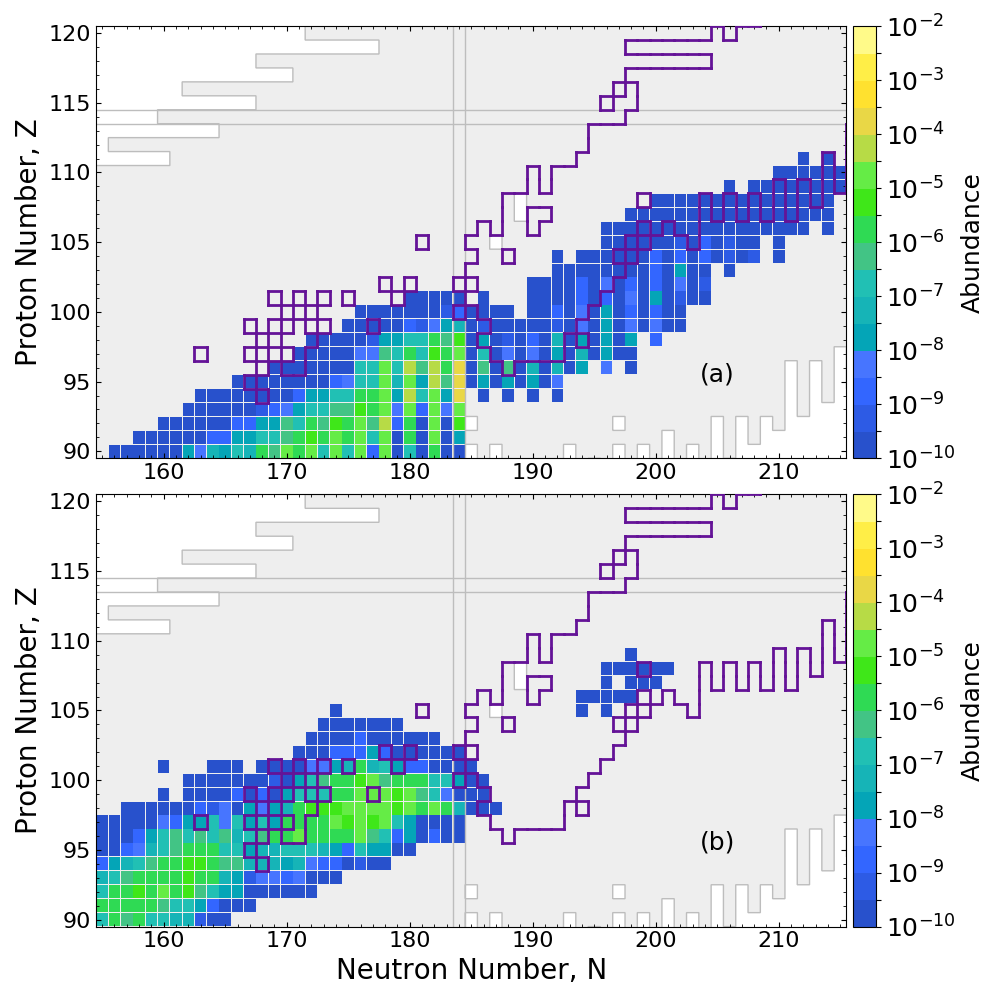
PRISM network calculation of neutron star merger ejecta
$\beta$df alone may prevent the production of superheavy elements in nature
Impact on final abundances
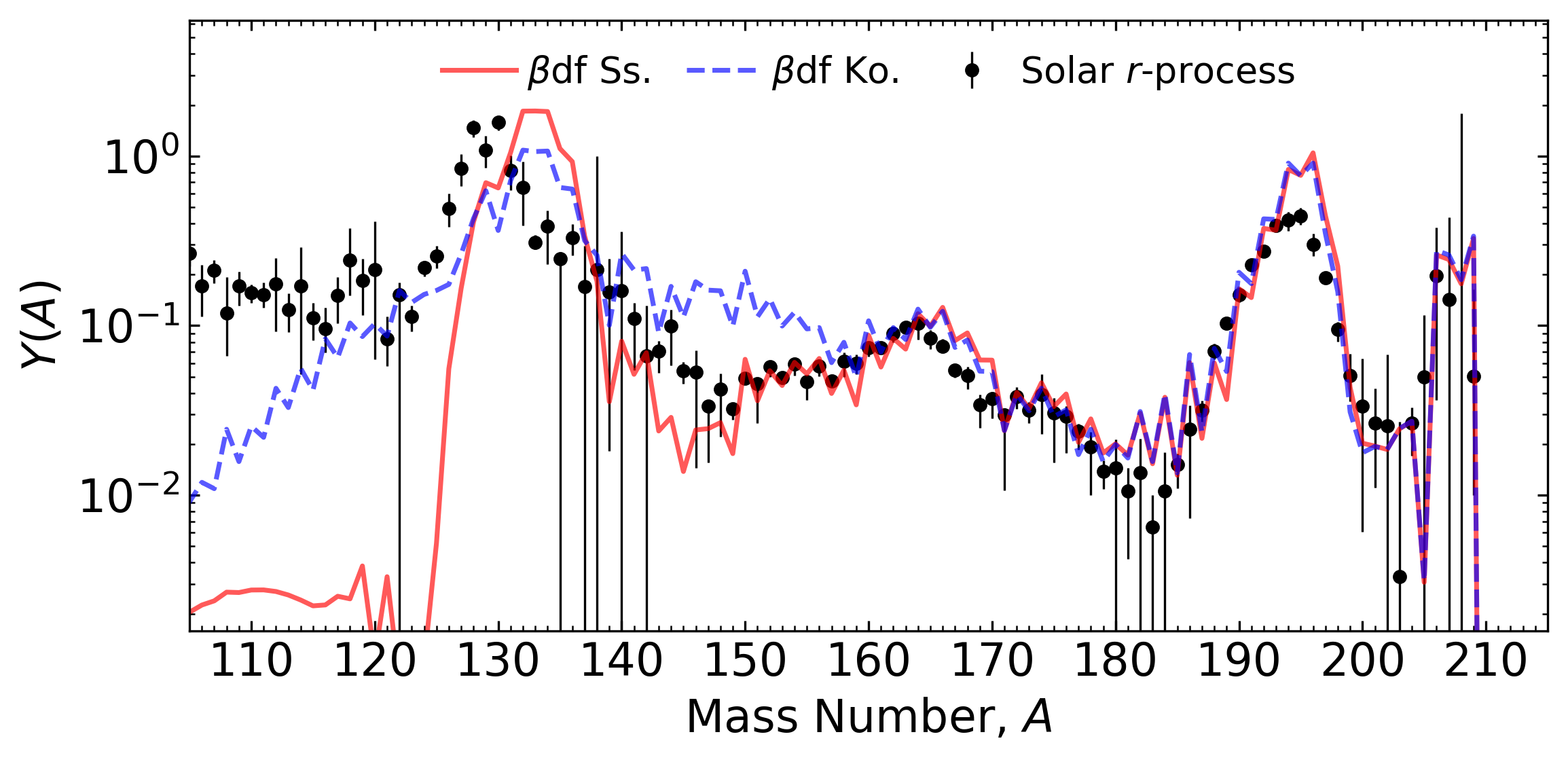
Network calculation of tidal ejecta from a neutron star merger (FRDM2012)
$\beta$df can shape the final pattern near the $A=130$ peak
This is because of a relatively long fission timescale
Conclusion ⇒ we need a good description of fission yields to understand abundances near $A\sim130$.
Fission hot spots
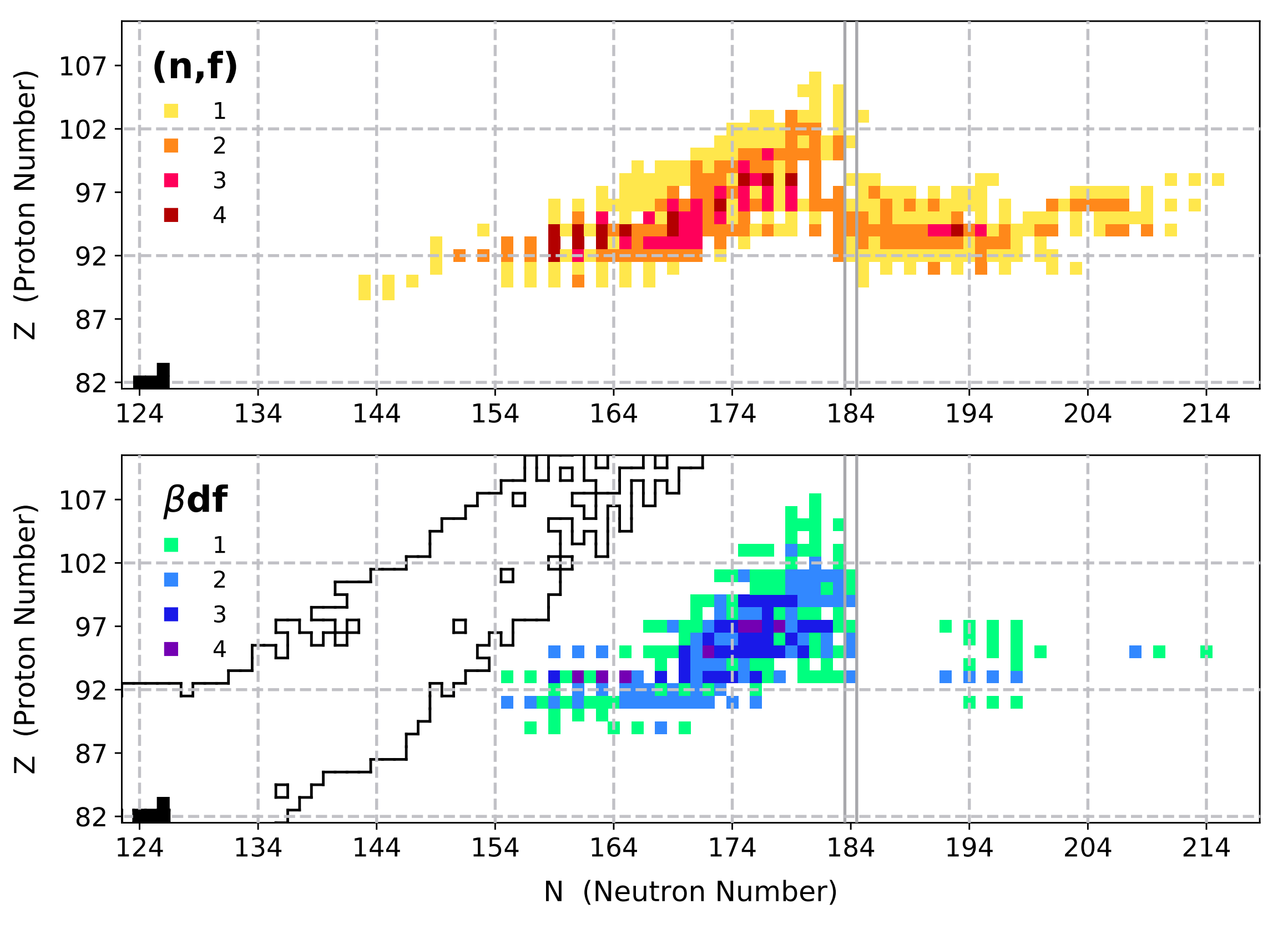
We've taken a look at the region where fission seems to occur the most
With variations in both astrophysical conditions and nuclear models
Nuclei which influence the final abundances are colored for (n,f) and ($\beta$,f)
Can we observe
actinide production?
One example: $^{254}$Cf(Z=98)
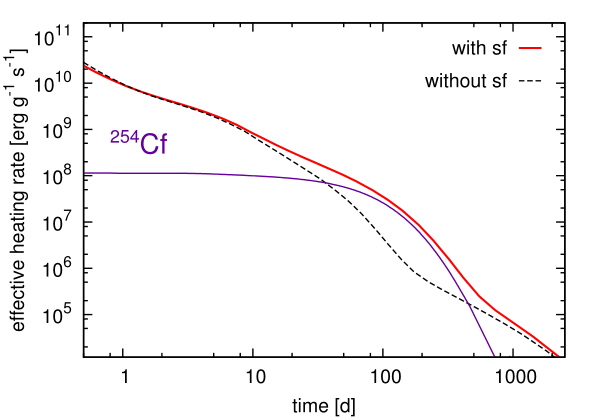
Is there any possible precursor to show that actinide nucleosynthesis has occurred in an event?... Maybe!
The spontaneous fission of $^{254}$Cf can be a primary contributor to nuclear heating at late-time epochs
The $T_{1/2}\sim 60$ days; found from nuclear weapons testing
Vassh et al. J. Phys. G (2019)
Production of $^{254}$Cf(Z=98)
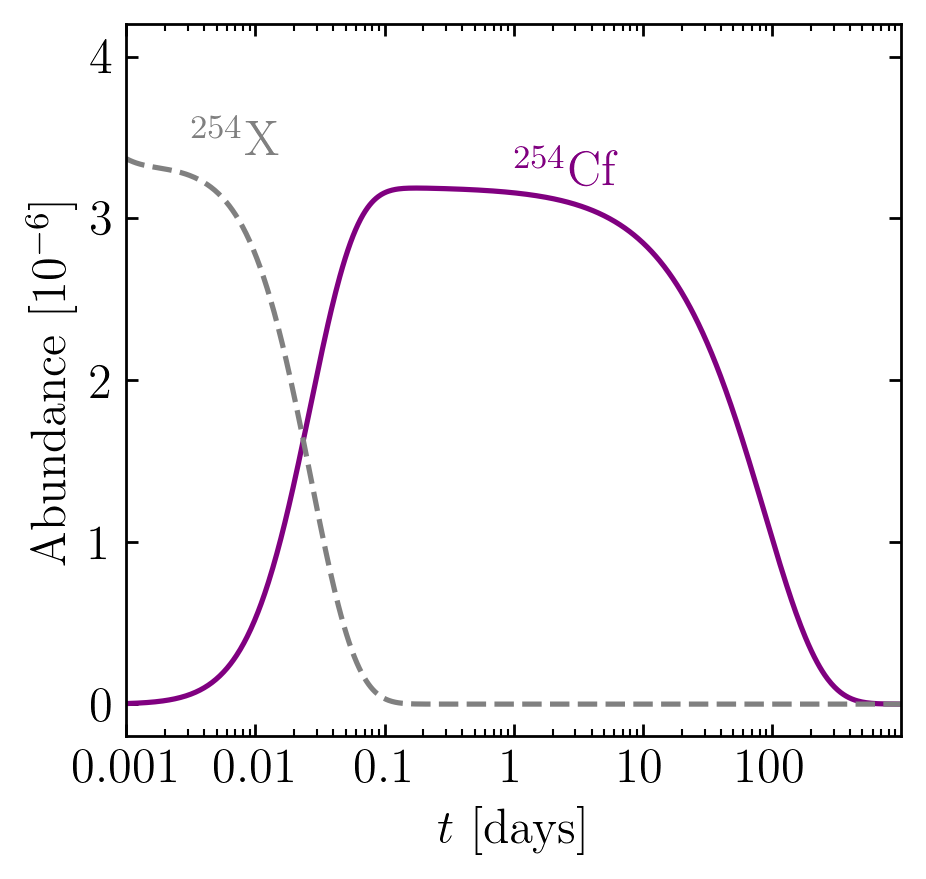
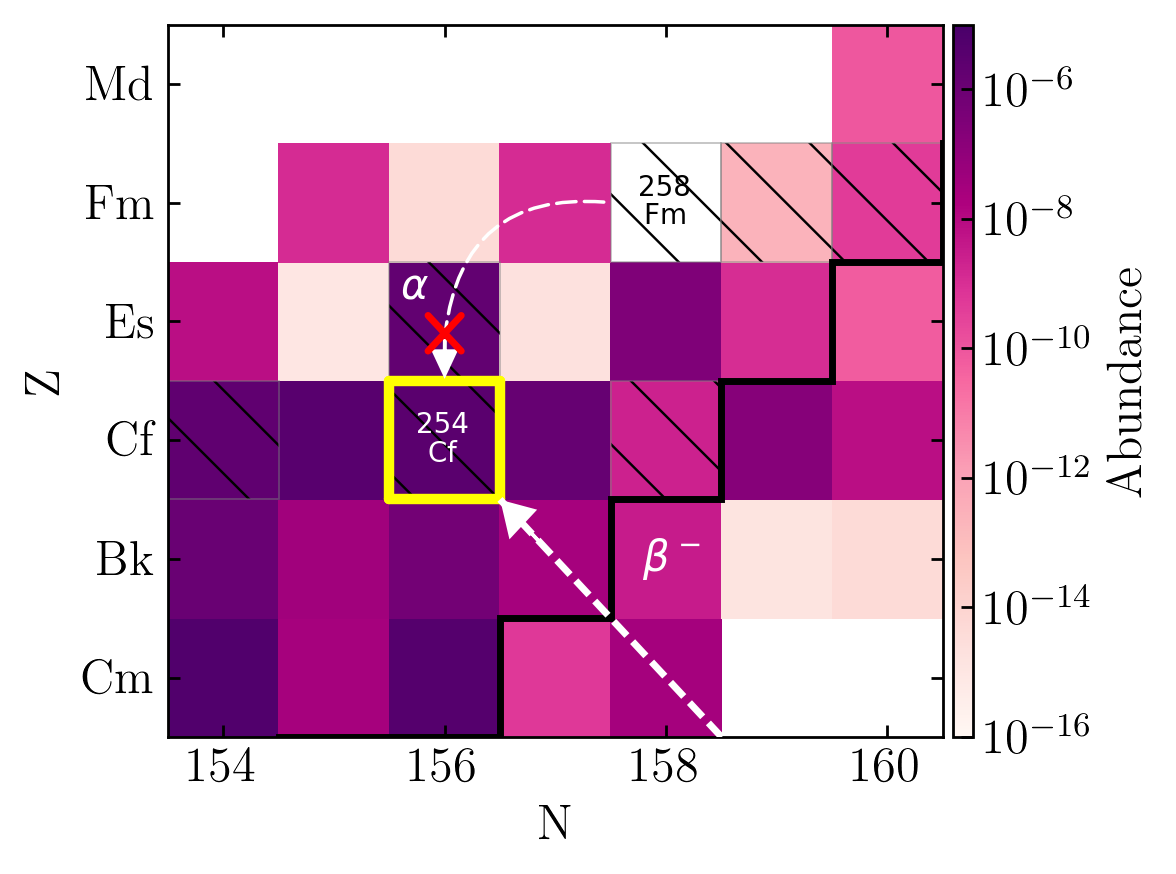
Primary feeder seems to be from $\beta$-decay
Production of this nucleus been explored over a range of nuclear models; some high - some low
Remains to be seen if we can disentangle from other late-time heating sources (e.g. puslar or accreetion fallback)
Production of $^{254}$Cf(Z=98)
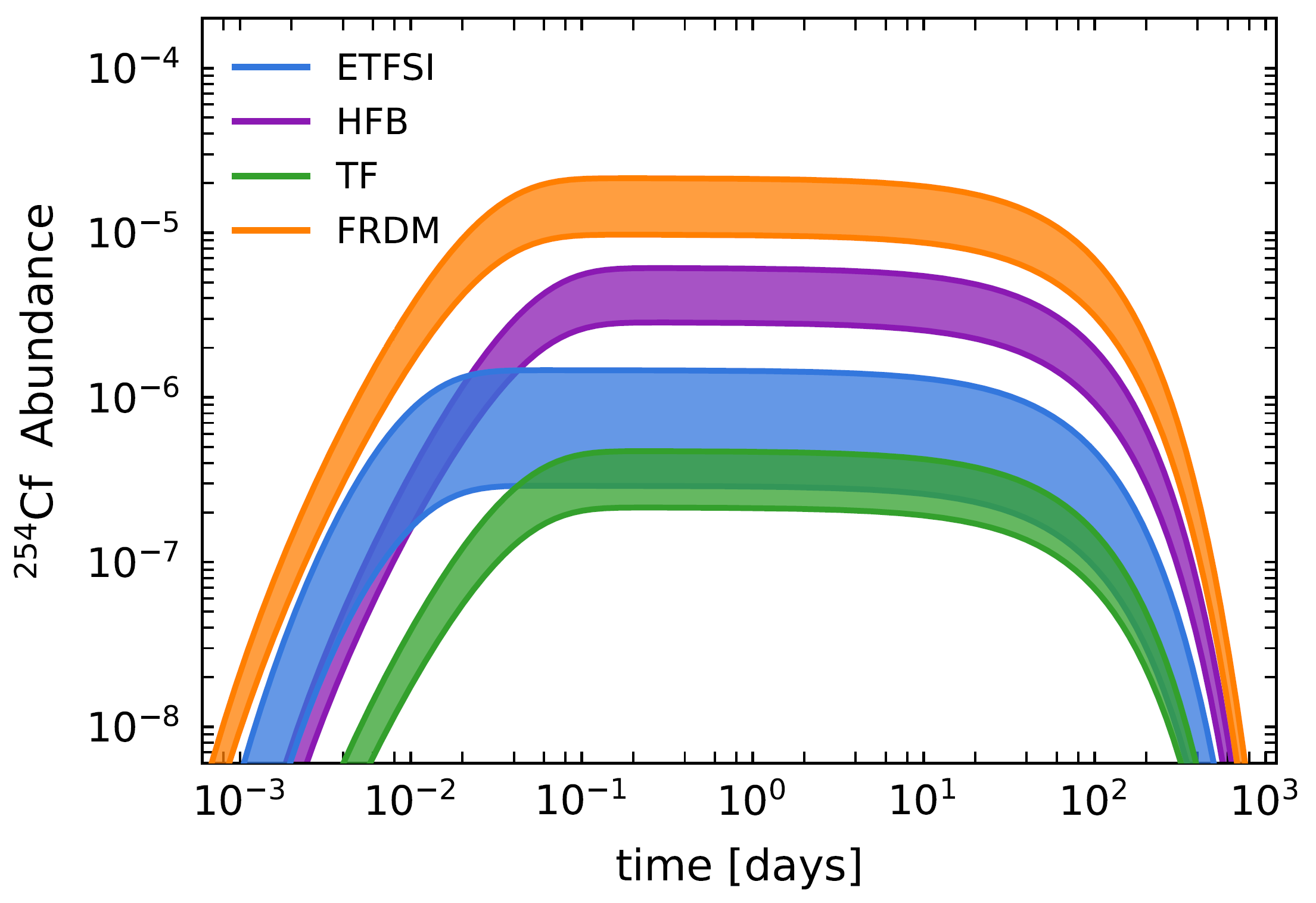
We have also looked at the variation of production in this element with change in fission barriers
Observational Impact of Californium
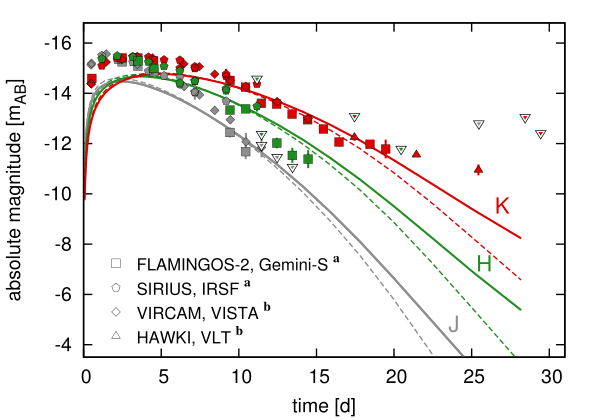
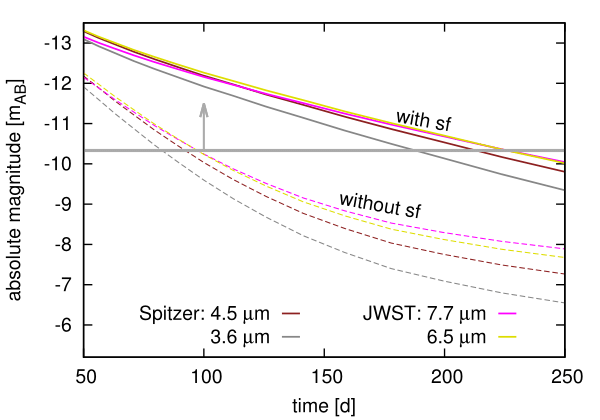
Both near- and middle- IR are impacted by the presence of $^{254}$Cf
Late-time epoch brightness can be used as a proxy for actinide nucleosynthesis
Future JWST will be detectable out to 250 days with the presence of $^{254}$Cf
This also has implications for merger morphology...
Merger $\gamma$-rays
Another possible (yet very difficult) option is to attempt to observe the spectra from transients / remnants
For the $r$-process we should search for signatures of actinides...
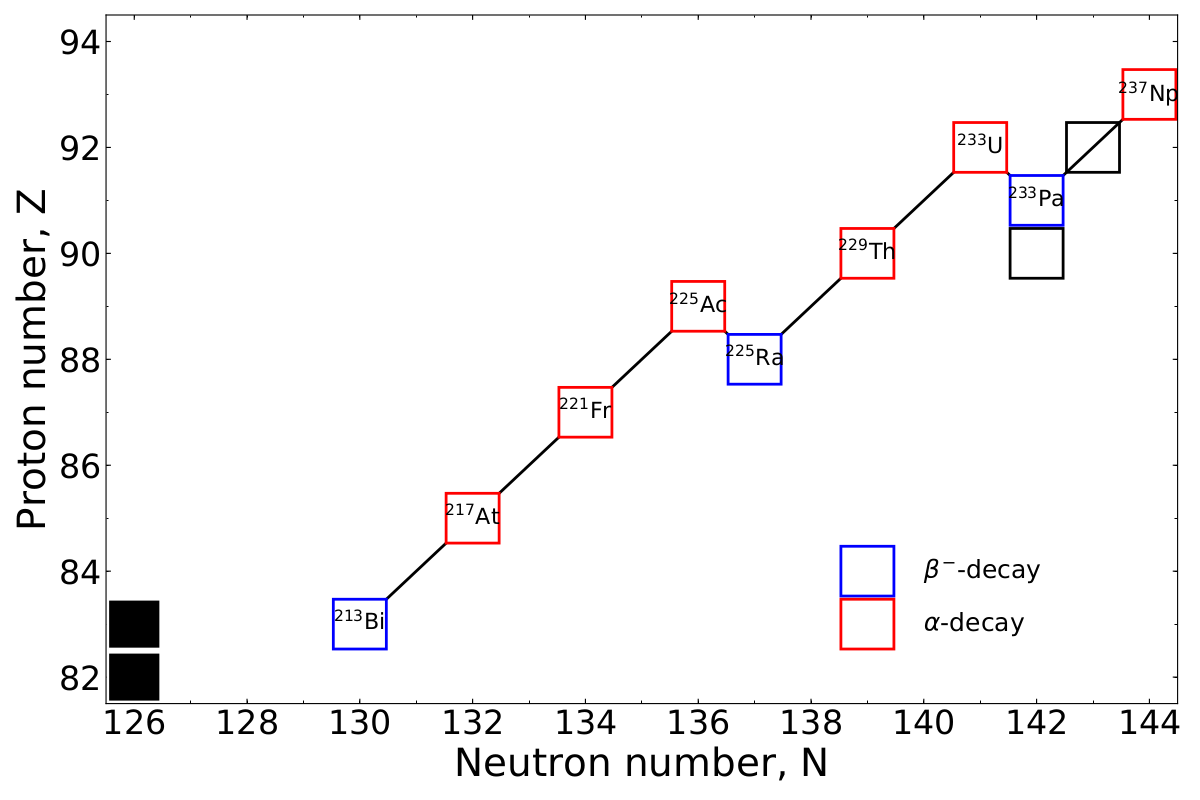
This involves following potentially complex decay chains...
$\gamma$-ray spectrum at 10 kyr
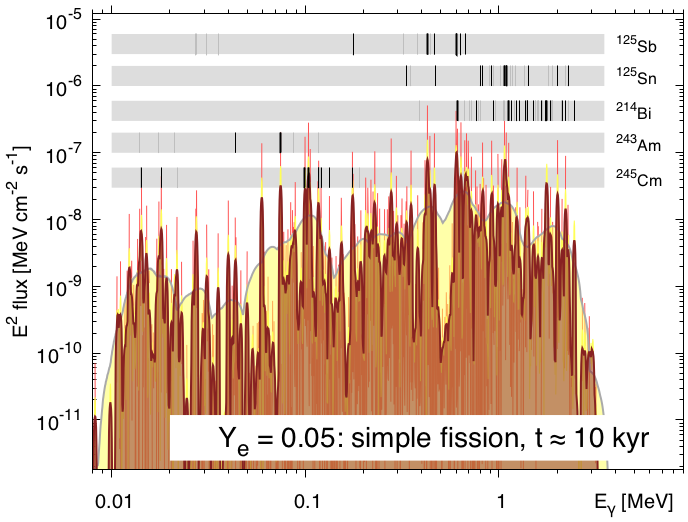
Distinct signatures do arise; despite line broadening
This depends sensitively on observational timescale
Can we do this with future space missions?
Observing $\gamma$-rays

Differing composition may be able to be ascertained, but the event has to be close (10 Mpc or less)
Possible candidates:
The Lunar Occultation Explorer (LOX)
Compton Spectrometer and Imager (COSI)
All-sky Medium Energy Gamma-ray Observatory (AMEGO) may all be promising
Special thanks to
My collaborators
A. Aprahamian, J. Barnes, A. Burrows, J. Clark, B. Côté, J. Dolance, W. Even, C. Fontes, C. Fryer, E. Holmbeck, A. Hungerford, P. Jaffke, T. Kawano, O. Korobkin, J. Lippuner, G. C. McLaughlin, J. Miller, W. Misch, P. Möller, R. Orford, J. Randrup, G. Savard, T. Sprouse, R. Surman, N. Vassh, M. Verriere, R. Vogt, R. Wollaeger, Y. Zhu
& many more...
▣ Student ▣ Postdoc ▣ CTA Staff ▣ FIRE PI
Summary
The production of actinides in the $r$-process requires a deep understanding of nuclear physics
Recent insights include:
modeling of astrophysical environments ▴ Multi-messenger observations
Nuclear theory predictions
FRIB, etc. will help to constrain nuclear models, but the heaviest elements will remain relatively inaccessible
We therefore need to keep developing and studying theoretical models of nuclear physics
Nuclear modeling is absolutely crucial if we want to prove definitively that heavy elements such as the actinides were made in an event
Results / Data / Papers @ MatthewMumpower.com